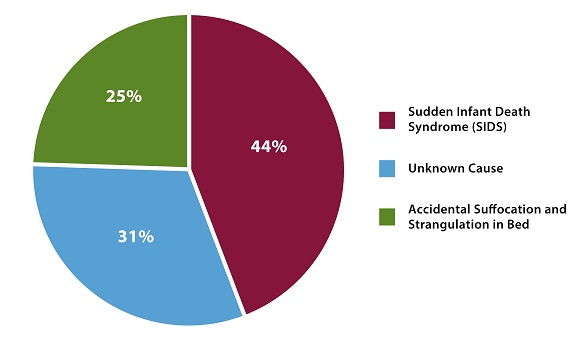Data and Statistics
Fast Facts
Each year in the United States, there are about 3,500 Sudden Unexpected Infant Deaths (SUID). These deaths occur among infants less than 1 year old and have no immediately obvious cause.
The three commonly reported types of SUID are
- SIDS. About 1,500 infants died of SIDS in 2014.
- Unknown cause.
- Accidental suffocation and strangulation in bed.
Breakdown of Sudden Unexpected Infant Death by Cause, 2014

SOURCE: CDC/NCHS, National Vital Statistics System, Compressed Mortality File.
This chart shows the breakdown of sudden unexpected infant deaths by cause in 2014. 44% of cases were categorized as sudden infant death syndrome, followed by unknown cause (31%), and accidental suffocation and strangulation in bed (25%).
Trends in Sudden Unexpected Infant Death by Cause, 1990-2014

Abbreviation: SUID, sudden unexpected infant death.
SOURCE: CDC/NCHS, National Vital Statistics System, Compressed Mortality File.
This graph shows the trends in sudden unexpected infant death rates in the United States from 1990 through 2014.
- The combined SUID death rate (which includes SIDS, unknown cause, and ASSB) declined considerably following the release of the American Academy of Pediatrics safe sleep recommendations in 1992, the initiation of the Back to Sleep campaign in 1994, and the release of the Sudden Unexplained Infant Death Investigation Reporting Form in 1996. The combined SUID death rate decreased again slightly beginning in 2009.
- Sudden infant death syndrome (SIDS) rates declined considerably from 130.3 deaths per 100,000 live births in 1990 to 38.7 deaths per 100,000 live births in 2014.
- Unknown cause infant mortality rates remained unchanged from 1990 through 2014. In 2014, the unknown cause mortality rate in infants was 27.3 deaths per 100,000 live births.
- Accidental suffocation and strangulation in bed (ASSB) mortality rates remained unchanged until the late 1990s. Rates started to increase beginning in 1998 and reached the highest rate at 21.4 deaths per 100,000 live births in 2014.
- Codes for cause of death were defined according to the International Classification of Diseases, Ninth Revision (ICD-9) for 1984-1998, and the International Statistical Classification of Diseases and Related Health Problems, Tenth Revision (ICD-10) for 1999-2004. We defined cause of death by using the following ICD-9 and ICD-10 codes: ASSB (E913.0; W75), SIDS (798.0; R95), and unknown cause, (799.9; R99) based on the underlying cause of death. The combined SUID death rate was the combination of ASSB, SIDS, and unknown cause deaths.
Sudden Unexpected Infant Death by Race/Ethnicity, 2010-2013

SOURCE: CDC/NCHS, National Vital Statistics System, Period Linked Birth/Infant
Death Data.
This stacked bar chart shows sudden unexpected infant death (SUID) rates by cause (sudden infant death syndrome, unknown cause, and accidental suffocation and strangulation in bed) and by race/ethnicity in the United States from 2010 through 2013. SUID death rates per 100,000 live births for American Indian/Alaska Native (190.5) and non-Hispanic black infants (171.8) were more than twice those of non-Hispanic white infants (84.4). SUID death rates per 100,000 live births were lowest among Hispanic infants (50.8) and Asian/Pacific Islander infants (34.7). SIDS comprised the largest proportion of SUID deaths for all racial/ethnic groups, ranging from 48% of SUID among AI/AN and A/PI to 54% of SUID among NHW. Accidental suffocation and strangulation in bed comprised the smallest proportion of SUID deaths for all racial groups, ranging from 16% of SUID among Hispanics, to 23% of SUID among NHB.
Data Resources for SUID and SIDS
US Vital Statistics Data
Downloadable public-use data files for independent research and analyses as well as annual infant mortality reports, are available from the National Center for Health Statistics.
Available datasets include
- Birth data files.
- Period linked birth-infant death data files.
- Birth cohort linked birth-infant death data files.
- Mortality multiple cause data files.
- Fetal death data files.
Data Access Tools
The following data analyses tools allow users to access and examine vital statistics and other population data interactively are available online:
Health Data Interactive
Allows users to access and examine data interactively, including low birth weight, preterm birth, and infant mortality.
CDC Wonder (Wide-ranging Online Data for Epidemiologic Research)
Allows users to query CDC data sources, including National Center for Health Statistics birth and death data using a menu-driven system.
WISQARS (Web-based Injury Statistics Query and Reporting System)
Allows users to access and examine injury-related data to generate customized reports.
PRAMStat
Allows users to access data for epidemiologic research collected through Pregnancy Risk Assessment Monitoring System (PRAMS) surveys and may be used to access data related to infant sleep practices.
- Page last reviewed: February 8, 2016
- Page last updated: February 8, 2016
- Content source:


 ShareCompartir
ShareCompartir
